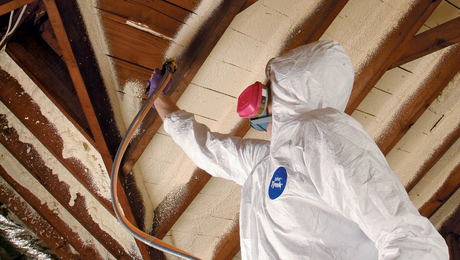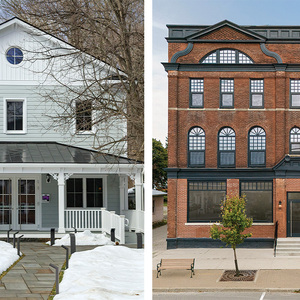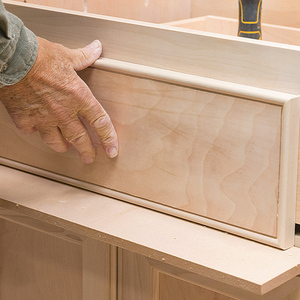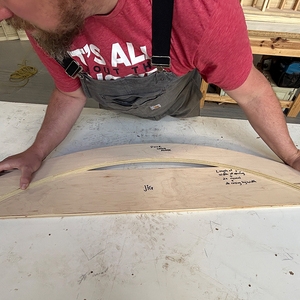*
I am considering the purchase of a sturdy 1948 bungalow in Lee County, Alabama. About 2200 sq ft, one floor,attic, slab foundation, asbestos shingles (in good shape but for a few chipped pieces) over tar paper with 1 by 6 pine board diagonal sheathing over 2 by 4 studs. Interior walls and ceiling looks like perforated drywall with a plaster skim coat (rocklathe?), in pretty good shape.
The current occupant says the utility bills run $300 a month in the winter – no surprise, since there is no insulation in either the walls or the ceiling. A local house inspector suggests I blow insulation into the attic and not to bother to insulate the walls, but if I really wanted this done the most common local technique is to attach foam board on the exterior walls and reside with vinyl siding. This doesn’t sound appealing to me, but I wonder if drilling holes in the exterior or interior walls to fill the stud bays with foam or cellulose insulation is practical with these wall materials. And after all, it is in the sunny South, so maybe insulating the ceiling and getting a new furnace would be good enough.
Any recommendations?



















Replies
*
Totally hollow walls make me nervous. Maybe one of the insulation experts will be along, but it is really not such a big deal to get those holes through plaster to blow in cellulose. Can be a little messy if somebody like me does it, unoccupied or occupants on short vacation would be good. Then seal up your windows and doors. This all would be a radical comfort improvement.
*Dear M,I need a victim, and it looks you're it. Vermonters are over-qualified in most aspects of life, so I feel perfectly competent to comment on sound Alabama insulation measures.Spending $200 a month on space heating is nuts. A million miles north of you, I'm heating a bigger house all winter for $400. And less you think I'm bragging, this rate of consumption is an embarrassment to me. (((It's my wife. She likes it over 75F)))So what are we going to do about this house? And congratulations btw. Your house inspector was right to tell you to start at the top. First, seal the attic plane tight while you have the chance to do it easily. Learn how to do that here. Then burry everything in a foot of cels.New furnaces are ok. Tweaking the existing one is often just as good. But fixing ducts is God's work.You did ask about insulating walls and it would be rude not to address that measure. With my background of working with hard core, bottom line energy nuts, we didn't put a lot of stock in wall insulation. You see, even when they are empty, the net resistance is around R-4. Packing them full of cels, might get you a whole wall resistance or R-6. If you could find a fanatic like me to drill and probe your stud bays, maybe I could get you R-7 or 8. Not very exciting stuff in the conservation world.But the Cat here, makes the key point. "Totally hollow walls make me nervous." Yup, that's it. Hanging around in the Energy Folder, we've lost focus. Packing the walls makes the house much more fire resistant. And moisture resistant. And bug/rodent resistant. And comfortable. That's where it's at. You get a safer, healthier, happier, more durable house by packing the walls with DP cels. How can you put a price on that?Cordially, Fred
*Thanks for info. I've been lurking here for years and never heard of Home Energy Magazine - a nice resource.I've talked with two local insulation contractors since my posting. They both said about the same thing - do the ceiling, forget about the walls. One noted that he frequently encounters blocking that makes it a challenge to fill the stud bays. The other pointed out that a certified asbestos handler is required to pull off the outside shingles, and that Georgia Power says that 80% of energy savings occurs with attic insulation, 15% with wall insulation (and 5% with floor insulation).I guess I'll start with sealing up that hole in the ceiling where the attic fan used to be, have the attic filled, and think about wall insulation after we see next year's utility bills.Nice to see you back, Fred. Don't forget to wear a hat when you go to the beach. We need you around here.
*FreddyL,Did you just come back to sell your snakeoil wares again?Take your business somewhere else. You have no honor and no shame.Gabe
*Dear M,That sounds prudent. I took a quick look at your Georgia Power percentages and said "Huh?" That's not how we see things in VT. Then remembered you probably don't have to worry about a lot of solar gain from the floor. Ha ha. I guess climate does matter.Taking your advice seriously, Fred
*That's 1
*Lighten up, Gabe. In this case, Fred's advice is right on the money and I'm sure much appreciated by the poster. Who are you to tell anyone they can't post here?
*Crusty,Never said anyone couldn't post. What I'm reminding everyone is no one is above the no selling policy on this board.BTW Fred isn't right on the money on this one either.Gabe
*lee county, thats around Auburn, WAR EAGLE. You are couple hundred miles north of me. Tomorrow night it will be in the mid twentys. two weeks from now it will be in the eightys. First week of august it will be around 103 in the shade. Insulate the muther to the gills, not just foe heat but a/c too. The house I'm building I plan on r30+ in the ceiling and everything I can get in the walls.
*> BTW Fred isn't right on the money on this one either. Gabe,Then what is your answer to Msteinkampf? It isn't very helpful to just say that someone else's answer is wrong.Rich Beckman
*Rich,How about you telling us what you understood FreddyL's answer to be?The short version please.Gabe
*Although I fail to see the relevance of what I understand... I think Fred told them to seal the attic floor (which , as far as I can remember, no one has ever said is a bad thing to do) and then blow a foot of cels onto it. Then dense pack the side walls with cels.My understanding of what you said is that Fred is wrong.My understanding of what your advice would be is completely lacking bacause you have failed to give advice.Rich Beckman
*First off Rich, I'll ignore the arrogance in your reply. I know you're a wannabe expert and that's life.The two things that caught my attention with this post were the words "asbestos" and "attic".When the day comes that the poster wants to insulate the walls, off comes the asbestos and all the options are open to him, depending on his needs and wallet. So for the time being it's not part of this discussion.Now the word "attic" comes back into the discussion. The questions are now, is the attic usuable or will it ever be usuable? Is the attic vented or note? How much moisture are we likely to find in this attic? What kind of roofing does this bungalow have, is it covered in tin, asphalt shingles, is the roof sheeted or with intermitent boarding?Not knowing everything about the subject matter and spewing forth a 2000 word essay with links to the world is not an answer. It's an opinion based on no information.My first reaction was to foam the underside of the roof, including the end gables if there were some and be done with it. In Alabama you wouldn't need anymore than 2" between the rafters and studs. This would also guarantee a proper vb overhead.This way you gain the space available in the attic for storage or other uses as well.Having said all that, it's likely by simply sealing with a can of foam and changing the furnace that he would cut his heating bill in half anyways. It's the cooling needs that might be thougher to deal with.GabeThere's always more than one way to skin a cat, only the cat would disagree with all of them.
*LOL! Well, I may (or may not) be arrogant and a wannabe expert, but I'm sure there a lot of people that appreciate your constructive input to the thread, including me.Thanks,Rich Beckman
*I'm sorry, I retract my openning remark. I may have read something in your post that wasn't there.Gabe
*> I'm sorry, I retract my openning remark. I may have read something in your post that wasn't there.No problem.Rich Beckman
*Shallow gabled roof with vents in the soffits and the gables, plywood sheathing, composition shingles in good shape, attic only about four feet high. Not really usable, but there must be 20 years of discarded college student furniture up there right on the rocklath - no wonder there are so many cracks in the ceiling plaster!
*Fred, please explain.You said "Packing them full of cels, might get you a whole wall resistance or R-6. If you could find a fanatic like me to drill and probe your stud bays, maybe I could get you R-7 or 8."I don't buy it, but then again, I learn something new everyday. The bit about Vermonters was good. Must be a small state thing. ;)
*Dear Tim,When we model the behavior of house or thermal envelope, we want to know the difference between the insulation R-value and the 'whole wall' R-value. You see how these are two completely different things?For example, you build a section of 2x6 wall and slap in some R-19 batts. Then you take the assembly and load it into a giant climate simulator. Now you can actually measure the performance of the 'whole wall' including insulation, lumber, wiring, etc.I have friends who really do this. Their results are disheartening. But the other benefits of solidifying walls cavities are far more important that boosting their thermal performance. That make sense?Living in a dumb state, Fred
*FredL,I am accustomed to seeing stud and batts rated at 85-90% of the batts (with studs on 16" centers). I would assume that cells are treated the same way. In a "standard" wall, (i.e. 1 bottom plate, 2 top plates, 92-5/8" 2x4's on 16" centers) I would think that the insulation leaves little uncovered space. I know mine are filled plate to plate. I can see the occassional wire changing this some (and if you run pipes in an exterior wall [bad idea]). I have never seen any real test data to verify this, though as I said, I learn something new everyday.In my envelope construction, all wires, pipes, vents, etc, are run in the inner of 2 stud walls.Any organization ever publish tests like this?Tim
*Tim, the ideal wall assembly would be constructed backwards.Spray 2 to 3 inches of foam from the outside onto the back of the drywall, stud to stud and cover every outlet. Then you install the permanent sheating and wall finish.
*Dear Tim,You ask the good questions.I know that Oak Ridge National Labs and Concordia University both do this work because I've spoken with scientists there. Scandia, Pacific Northwest National labs, and Lawrence Livermore may also. If you google them about wall insulation, you'll get an avalanche. Jeff Christian (ORNL) told me to expect a 40% discount on the whole wall number from thermal short cuts. (he backs off a bit in public) Others have suggested batt installation defects can take 30-50% of what's left. Just a 3% miss in coverage will degrade the insulation performance 30%. There have been pictures published in FHb on fg that show 3% misses. To work well, the insulation must contact all the framing, but also snug against the wall interior and exterior. They can't even do that with one bay in a lab with batts. So I gave up trying. If you have FHb #130, take a look at the wall sample Andy and I cooked up out of scrap. We loaded it with pipes, boxes, wires, and then covered it with glass. I filled it with cels and he photographed a sequence. Historic stuff.Oh, and after all the technicalities, bear in mind that walls rarely make a stunning difference in overall thermal performance until you get to Gene Leger heights of building quality. (scroll and read "Progress?" letter)Regards, FredTheoretical disclaimer: Mike warns us that this is all just a theory.ha ha, look what the tide brought in
*Tim,What FredL forgot to mention was that he didn't know the answer to your question but would like to refer you to others who know. Beware of anyone who quotes percentages and is not in a position to have to back em up.All dry insulations have the probability to have change. In other words, to sag or leave voids. Even a mouse wouldn't know the percentages.
*speaking as a guy who plays a weatherization expert on my homepage....damn .. did i say weatherization expert... i meant BS detection expert... fredl... give it a break... your gonna burn yourself out just like the last time... find someone else to try and bait....
*FredL, LFred, xMike,My experience, though not that extensive, is that insulated walls are always a major part of the thermal barrier and performance counts. I calculate heat gain and heat losses based on stud wall having an average of 90% of the insulation value, as is standard practice in this industry. Inleakage, roof insulation, glazing insulation values, etc., all play major roles as well, but if I had to derate insulated walls another 20-30%, a lot of buildings around here (and the country for that matter) would have insufficiently sized heating and cooling systems. Such as not the case or I would not be in business.I wonder, though, (and a little research will probably answer this question) don't insulation manufacturers test their products and rate them with a little margin?
*Yes the majors factor a reasonable site condition margin.
*Interesting discussion. We decided to buy the house, so we had the place inspected. Someone had thrown some furniture over one of the ducts in the attic and made a big dent. The inspector said he could get both hands into the space where two pieces of the duct had separated. The present occupants are heating and cooling the attic through the hole.
*Dear M,A big duct breach. Yes, it's common in attics and cellars. Now you have the opportunity to spend 50 bucks on the ductwork and do more good than blowing the walls for 2 grand. Does it get much better than that?Congratulations, Fred